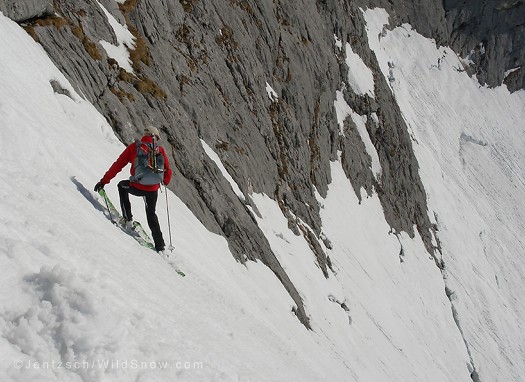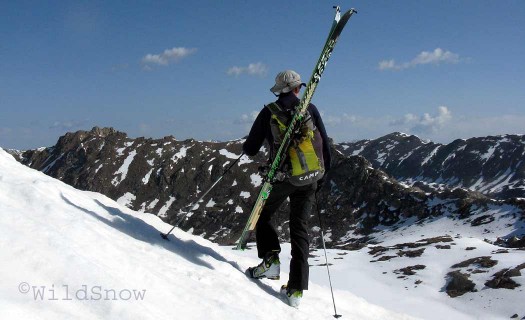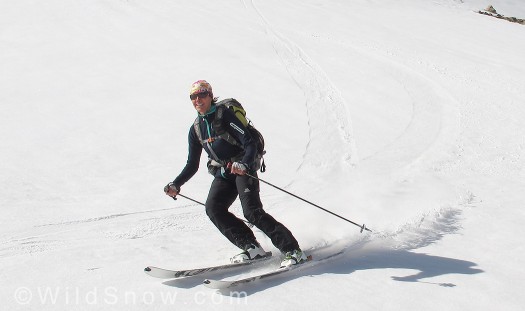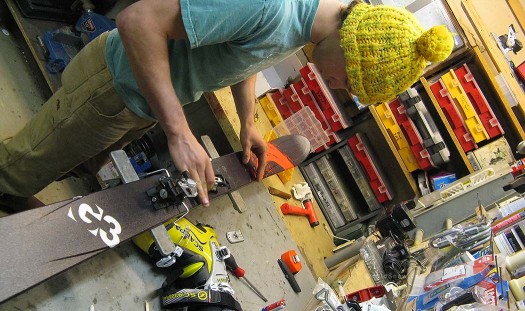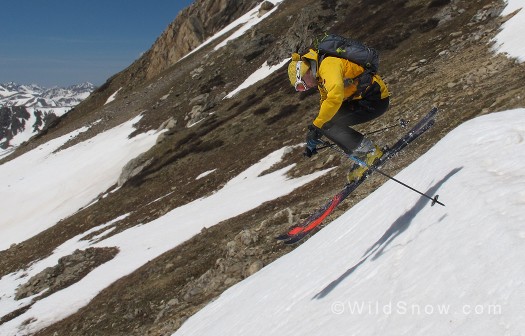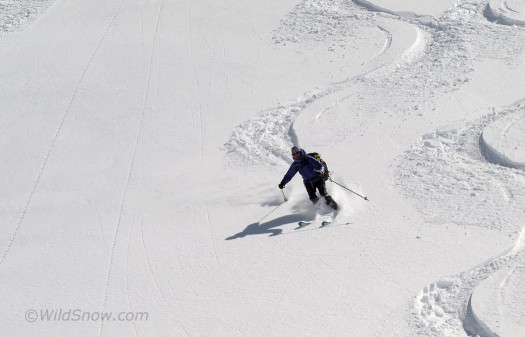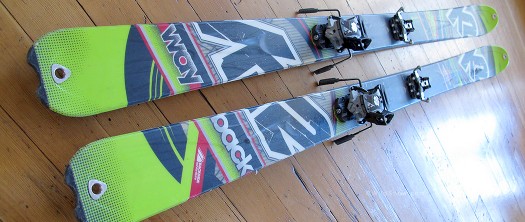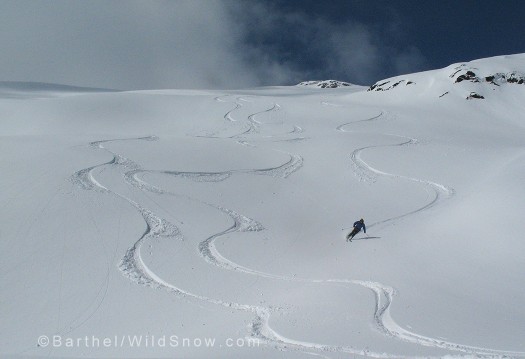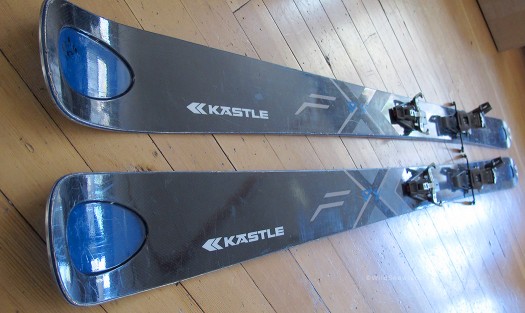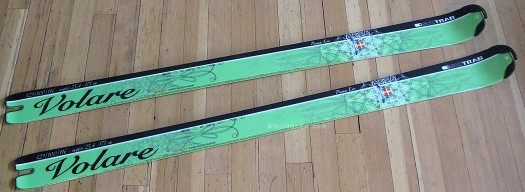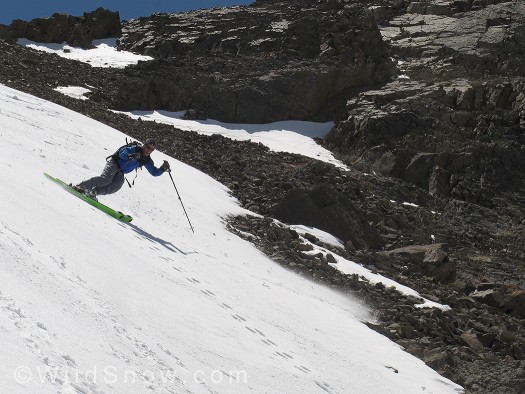Okay guys and gals, it is time. Time for us to bring our Ultimate ski review up to the top again for your autumn fantasies, or perhaps even some shopping. We truly enjoyed doing our own style of ski review last winter. We hope you’ll get some good use out of it.
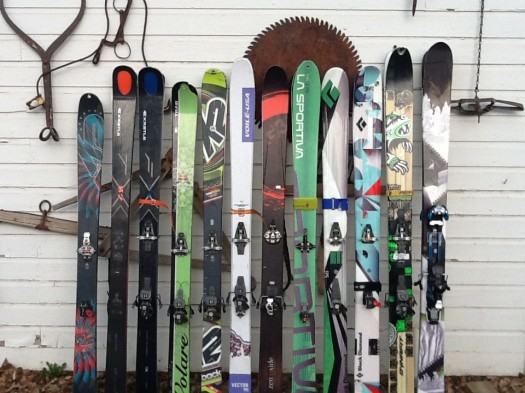
Most of the skis in one place at one time, but not all (plus one extra we didn't include below). We constantly have them out for testing or have returned to owner. The joie de vivre of this project is truly the pleasure of having to ski each pair of sticks to come up with a verdict of which ski is the best for each skier, terrain, fitness, and so on. It was a fun long winter without a doubt, though our lack of snow here in the western U.S. delayed our progress substantially.
Never to be outdone by the original 11 pairs of the Ultimate Quiver Lou presented last winter in his jealousy inducing teaser, we’ve got a few more in our final stack. The way this works is every ski below is good, but each one has its niche in the quiver. Some are perhaps better for pure spring touring. Others are powder busting machines or sidecountry units, still others might be more appropriate when your vertical is assisted by machinery, and so forth.
Our bias is obvious: For the most part we reviewed skis that have what we feel are excellent performance to weight ratios — for human powered backcountry skiing. Though popular in some circles, we did not include extremes such as skimo race skis and gigantic support planks for TGR stardom, as the bulk of human powered backcountry skiers are on a sweet spot represented by the skis below. As are we (sweet, that is.)
We made a stab at ratings — 5 stars is best. Ratings can be bogus. They depend on how a ski is tuned, what boot/binding combo is used, who is skiing on it, length tested and more. Thus, don’t take our nitpicking little stars too seriously and know that certain fixed factors influence the ratings. For example, wider skis tend to work better in soft snow, so they tend to get more stars in that rating category. Again, note that we like every one of these skis and the ratings are simply intended to help you pick what is closest to your style. Also, we reserve the right to slightly adjust our ratings based on continued experience with these skis, as well as feedback from other users. The skis are listed in alphabetical order.
Skads of good skis are on the market beyond what we picked here, so please keep that in mind. This stuff is what caught our fancy and was available for testing without us trying to become a ski magazine with ten editors, a beer sponsorship and a shipping department. More, we didn’t obsess on reviewing the latest stuff, we just reviewed what we wanted. Result, some skis are super available, now. Others, such as the Voile Vector, sold out (because they are “ultimate”) and may still not be available.
And yes, we provide as many shopping links as we could find. So thanks for enjoying the review, doing any shopping you feel like (which helps support our work here) — and of course your comments!
Black Diamond Element Shop for BD Element
Length tested: 175 cm, Sidecut: 141/115/123, Radius: 23m, Weight per ski: 68.9 oz, 1952 g.
Soft snow: *****
Hard snow: ***..
Weight/Performance: *…
Element is an aggressively rockered alpine ski, said to be women’s version of BD Amperage. While most backcountry skiers don’t make a habit of hauling around skis this heavy (and perhaps not even this wide), Element is nonetheless something to consider if you want a wider plank with superb performance, and you perhaps even like the feel of having a bit more weight in the ski. We included this plank in our quiver as a sort of an “outer limits” choice, or a ‘sidecountry’ rig.
Lou: “I skied both Amperage and Element on a powder snowcat day when these skis were first released. I found the Element more likeable and thus chose it for the quiver as I knew it would be good for me, and probably for Lisa. It’s also quite nice on the hardpack.”
Lisa: “These skis were a revelation for me. I finally learned what riding the ski is all about, as I did easy smear turns all the way down the mountain. They’re too heavy for the big ski tours Lou and I frequently do, but nice to have something in the quiver that’s more at home on the resort hill. For a go-to ski I’d probably ski them one step shorter — on the other hand, it was fine to let those long sticks take me down the hill.”
Bob Perlmutter: “Last season I skied the BD Element as well as the Amperage. Put another way, girl ski vs. boy ski with the same dimensions. My memory of the Element brings to mind the Cyndi Lauper tune “Girls Just Wanna Have Fun”. In which case I wanna be a girl too because boy I sure was having fun and felt right in my element in the soft stuff on the BD Element. Effortless, easy and playful. My first thought was what a great mid winter touring ski this would make if you’re willing to haul a bit of weight.”
This plank works so well we’d consider hauling it around for all types of soft snow. Since Element is an alpine ski it does have some hard snow chops, but don’t expect major trenching or edge grip as that’s not the style intended. Adding to the weight, the tail and tip areas of the Element have deep indentations in the surface skin that catch snow and ice, resulting in the ski sometimes becoming impracticably heavy for most mortals.
Black Diamond Justice (newer carbon version) Shop for BD Jusice
Length tested: 175 cm, Sidecut: 138/111/123, Radius: 31m, Weight per ski: 63.3 oz, 1794 g
Soft snow: *****
Hard snow: ****.
Weight/Performance: *****
With the addition of carbon, the lastest Justice (2012/13 version is unchanged from 2011/12) is lighter than previous versions and better all-around. With moderate tip rocker and a small amount of tail rocker, this plank yields good bite and carve on piste, while being excellent in soft natural-snow conditions.
Lou: “This was my go-to ski during our Colorado early winter facet snow weirdness when we were literally skiing inches above the ground with three feet of depth hoar washing up around our knees and hips. They worked. I enjoyed them on hardpack as well.”
In sum, excellent, and if you’re looking for a one-ski quiver, definitely consider. Yeah, this is a short review, that’s because this ski is simple, effective, and worthy. One of the best deals out there in view of street prices. Period.
For those on a budget, the Black Diamond Justice is an excellent pick — for a bit more weight and a lot less money.
Dynafit Huascaran Dynafit skis on sale here.
Length tested: 186 cm, Sidecut: 135/114/124, Radius: 35/20/30m*, Weight per ski: 66.6 oz, 1888 g
Soft snow: *****
Hard snow: *….
Weight/Performance: ****.
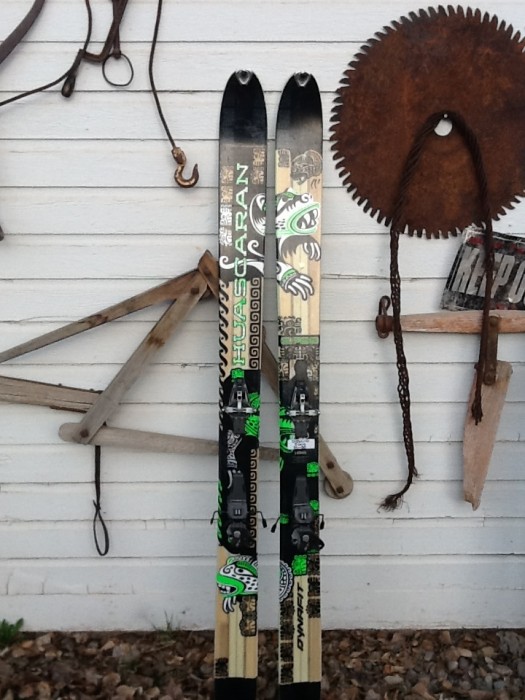
Dyanfit's newest and fattest offering, the Huascaran, named after an Incan chief and the highest mountain in Peru at 22,205ft.
Compared to the Dynafit Stoke, the Huscaran is a better ski. It fills the Stoke niche of providing width with less mass, but is so much more. Huscaran takes the Stoke concept of lightweight construction with width, but adds tip rocker and a bit of tail rise along with more girth (Stoke is 106 under foot, Huscaran at 114). This while retaining the Stoke concept of a straighter cut.
Lou: “Yes, Huscaran is what I’d call a modern ski, yet has that added feature of being fairly straight in sidecut rather than curvy. This makes the ski somewhat more predictable in situations such as breakable crust, and quite a solid ride in powder yet still with the desired surfy playful characteristics you get from rocker and width. Only downside is on hardpack you won’t feel that easy tilt and turn that more sidecut gives you. In fact, when I tested the 186 it took me a few tries to figure out how to initiate a turn on something moderately steep while not skiing at mach ten. Of course, at mach ten turn initiation is never a problem (though the sonic booms get distracting), so perhaps I disqualified myself as a tester. What is more, a 186 is probably too long a gun compared to what I always ski on, which could have had something to do with me flailing around with it. In any case, that’s my take.”
Joe: “Fast, you like fast? I mean like Steve Mcqueen “Bullet” fast? On the few occasions when the snow stability cooperated I was able to “slither” at 100% total yard sale speed down several couloirs with no problem and confidence in the 186 length (other then the ability to turn). I received an email from a fellow compatriot to ride these babies hard and fast. Truthfully I never liked how the Stokes 10/11′ & 11/12′ felt on the down and was a little cautious to open these skis up (speed wise) considering these would technically be a replacement for them. That being said don’t try to ski these skis at any slow speed with any DIN less than 10. On several occasions in-bounds I was able to torque out of the ski (easy to do with a 114mm sidecut on hardpack) with a ramped binding due to a demo heel setup. They did feel surprisingly light on the uphill with a Palownia core making for a quite a snappy disposition when the conditions called for it. The overall construction of the ski with bright green, see-through graphics, and lowered mounting points felt absolutely sublime. The upcoming winter, which will hopefully yield better, ehmm deeper conditions, these skis would become a definite horse that I could name “I’ll have another.”
Without a doubt I expect this super-lightweight 110mm+ waisted ski segment to grow as ultra stiff tech binding compatible boots get lighter and lighter. Nice to see the boys from Dynafit are among the first to answer that call.”
Also known as the “Land Fish” due to their distinctive graphics, we doubt Huscaran would be considered a quiver of one by most skiers. On the other hand, it’s a cool ski to have in the quiver as we doubt many other options will give you this much ski for so little weight. We’ve seen a few of these in Europe mounted with skimo race bindings. Cool.
SHOP FOR THAT LAND FISH (HUASCARAN) on sale here.
*Dynafit claims their triple radius provides better hard snow performance by virtue of the 20 meter radius under the foot area. In our experience this could very well be true and compensate somewhat for the relaxed sidecut.
Dynafit Manaslu (both men’s and women’s tested) Dynafit Manaslu on sale here.
Men’s length tested:178 cm, Sidecut: 122/95/108, Radius: 31m, Weight per ski: 50.5 oz, 1432 g
Soft snow: *****
Hard snow: ***..
Weight/Performance: *****
Women’s length tested:161 cm, Sidecut: 109/74/96, Weight per ski: 41.1 oz, 1164 g
Soft snow: *****
Hard snow: ****.
Weight/Performance: *****
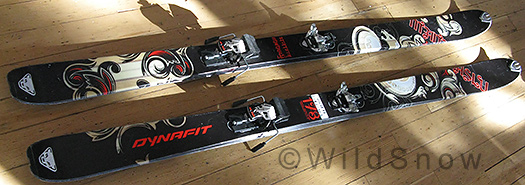
Dynafit Manaslu powder and crud skis delight self propelled backcountry skiers, 2011/2012 model continues what is now a classic.
Long a standard for harvesting soft snow under the power of human fuel, Manaslu (men’s) was recently improved with carbon fiber for better hard snow edgehold, as well as more aggressive (forward) binding positions dictated by the factory installed screw inserts. In general, we’ve found the new full-forward binding position to be too aggro, but the rearward position is quite nice for most people.
Lou: “I’m still partial to Manaslu as a human powered powder harvesting machine, but other similar width/wight skis with rocker tend to hold my interest as well. The improvement in hard-snow performance of the later model is welcome, as the original Manaslu was significantly lacking in that department.”
Overall, we’ve used and reviewed the Manaslu so extensively that we feel no need to repeat all that here. We like it and recommend it. Big thing, this is probably the lightest ski in our quiver (hard to say exactly, as weight is also a function of chosen length), and it’s still got some length and width! Super. Check our reviews over the years, this has become a classic.
The women’s Manaslu is similar to the current men’s version and is said to be somewhat the same ski as the first generation Manaslu. It is slightly lighter in weight then the men’s version and graced with high-key white graphics. Lisa’s 161 cm testers weigh 41.1 ounces (1164 grams) each, which means they’re the lightest ski in this review and only two ounces heavier (each) than her Goode Carbon 95s. We’d recommend that women shopping for Manaslu skis test both the men’s and women’s version. We suspect the men’s is better on hard snow, and might not be as silky in the soft as it is indeed beefed up from the older model. The men’s version weighs more and doesn’t have the nice graphics. Your choice, girls.
Lisa: “I haven’t had a chance yet to ski the Manaslu in powder, but they’ve been fantastic in variable conditions this spring. I appreciate their light weight on long approaches or when carrying them on a pack. This airy ski performs like a much beefier model. They cut through frozen suncrust with acceptable edgehold, and glide through softer snow like spreading butter on toast. With its beautiful graphics, this elegant ski is a fun, stable ride.”
G3 Zen Oxide G3 skis on sale here.
Length tested: 178 cm, Sidecut: 131/105/123, Radius: 27m, Weight per ski: 63.9 oz, 1810 g
Soft snow: ****.
Hard snow: ****.
Weight/Performance: ***
We can easily state that the Zen Oxide is one of those skis that is at home on the piste as in powder. That doesn’t mean you’ll be World Cup slalom racing on these planks, nor surfing like you’re on a true wide-body. But need to travel with one ski, or, gods forbid, own only one ski? If so, consider these guys.
Joe: “I got out on these skis in so many conditions; rock hard ice, blower pow, wind blown crust, moguls, untouched corduroy (I live within spitting distance of a resort and taught skiing all winter) and any other snow condition, you name it, these skis saw it. They were reliable as anything (though I did have to do some tuning work to get them skiing the way I like). I chose to take this ski out versus something fatter, skinnier, or longer because they just worked. Plain and simple. Sidecut and dimensions that weren’t bloated or unnecessary plus an overall predictable stiffness in and out of turns. On those days where conditions where variable (most of our Colorado season) I knew that I could trust these Cadillacs to deliver me down with the utmost predictability. My sole complaint is that the tips have a tendency to enable skins to slide off due to their thickness (with a G3 supplied skin). After hearing what Lee (read it here) had to say about next year’s version, I concur that these fit the bill for a do-it-all ski regardless of snow conditions.”
Louie: “I didn’t get to test these much, just some uphilling at the resort during the early season, but was impressed by the hardpack edgehold compared to our admittedly soft snow biased quiver. That said, they also work fine in the pow.”
Perhaps skis such as these obviate the quiver concept? Only if someone stole your whole quiver and you needed one ski to replace it. But then, those kinds of things do happen.
K2 Gotback K2 skis on sale here.
Length tested: 160 cm, Sidecut: 135/102/121, Radius: 18m, Weight per ski: 59.6 oz, 1690 g
Soft snow: *****
Hard snow: ***..
Weight/Performance: ***..
At first we left these out of the quiver, as Lisa reviewed K2 Gotback a while ago and they’re kind of old news. But we realized the error of our ways. Here at WildSnow HQ the K2 Gotback is the go-to plank for Lisa, as well as so many other women we know that we’ve lost count. This ski is not particularly light in weight, but it rides so well in so many conditions, you’re willing to haul a few extra ounces up the hill. Essentially the Gotback is the famed K2 Coomback, perhaps with some slightly different flex characteristics and of course different graphics.
Due to this ski being quite heavy we couldn’t with any integrity give it a high performance/weight ratio, but again, hauling the extra ounces could be worth it.
Speaking of Coomback, that’s still one of Louie Dawson’s favorite skis, which deserves mention. He’s not around to include his favorites in the quiver, so Coomback didn’t make it in — but honorable mention.
K2 Wayback K2 skis on sale here.
Length tested: 174 cm, Sidecut: 124/88/108, Radius: 22m, Weight per ski: 54.1 oz, 1534 g
Soft snow: ****.
Hard snow: ***..
Weight/Performance: *****
K2 Wayback is a standard in human powered skiing. Plenty of rocker, not too much weight. Just the right width to float you but not haul six tons of slush on top. We’d give these a 5-star for soft snow performance, except something wider has to keep that exaltation. Hardpack ride is acceptable, and they’re quite forgiving in conditions such as breakable crust.
Lou: “Let’s just say my 167 Waybacks are an amazingly efficient tool, yet because of the rocker they’re simply too short on the descent. I took the 167s to Denali so I could be ultra efficient and keep up with the young guys. The skis did the job on the up, but were too demanding on the downhills due to the short length. If I had to make the choice again, I would have brought the 174s combined with the lightest climbing skin and binding combo possible to compensate (a common setup you see in Europe with all sorts of larger skis). Funny thing is, I distinctly remember Mike Hattrup at K2 questioning if I really wanted the 167s. One should listen to their betters. (To be fair to myself, I still use the shorter Waybacks for things such as European ski traverses as the lack of weight and length is a joy — and of course if you’re a shorter person and not too heavy, the 167 may be perfect for you. The problem on Denali was I was trying to use them while adding a 50 lb pack to my body weight. That was a bit much.)
At any rate, the 174 centimeter version of Wayback is the perfect plank for my height and weight. They ride nicely through breakable crust, are too easy in powder, and acceptable on hardpack. In my view, a perfect all-around tool for human powered backcountry skiing. I’m not the only person who feels this way — I saw quite a few pair of Waybacks at the huts this winter in Europe. Paired with a glidy mohair skin, this is one of my main setups. ”
Kastle TX 87 Shop for Kastle skis here.
Length tested: 177 cm, Sidecut: 122/87/110, Radius: 20.5m, Weight per ski: 53.2 oz, 1508 g
Soft snow: **…
Hard snow: ****.
Weight/Performance: ***..
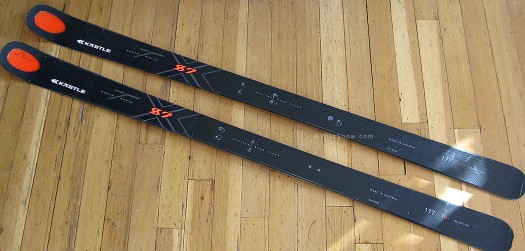
Kastle TX87 backcountry ski, winner of the 2011/12 Alpin Magazine ski test, is in that mid-fat width that's just about perfect for ski mountaineering.
Has the skiing feel (and somewhat the look, due to how the graphics play with your eye) of a more traditional European ski touring stick combined with modern dimensions. Lots of camber. No rocker. Edge grip like a wolf chewing a moose leg. Definitely a quiver ski, not a quiver of one.
Lou: “An excellent skier of the old school, tighter Euro turn discipline would love these. When thinking of this ski I have visions of a sun bleached pink scarf tied as a headband, Scott boots, cabin in Chamonix, and I’m on the first descent of the North Face of the Tour Ronde. But they’ve also been used by Davenport for skiing on Everest so they fit the modern mold as well. Or was he sporting a pink headscarf? I’ll have to check his FB.
Yeah, though still wider than the hippy sticks of yesteryear, the TX87 could be said to be less than average width for a modern ski (e.g., K2 Wayback is also on the narrow side, and is 88 at the waist). More, the extra camber and lack of rocker cause a traditional feel to dominate this ski’s ride. I’d keep these in the quiver for fun, mostly as something enjoyable for fitness uphilling on the hardpack. Reasonable weight is a plus.
Check out our translation of the Alpin Magazine ski tests.
Kastle Chris Davenport FX94 Shop for Kastle skis here.
Length tested: 176 cm, Sidecut: 128/94/117, Radius 20m, Weight per ski: 67.9 oz, 1926 g
Soft snow: ****.
Hard snow: *****
Weight/Performance: **…
As you can imagine, these rocket rides take no prisoners. If you want something that gives back everything you put into it, powder, crud or hardpan, look no farther. Roll ’em over on the piste and grab gobs of gravity. Slay powder. Your choice. Downsides? Heavy, a bit aggressive for mellow touring (no rocker, stiff), expensive. But if you’re an excellent skier who eschews rocker, likes metal in a ski, and wants something that supports your skills and fitness, look no farther.
One other thing: We do like to have a few sidecountry skis in the quiver — planks we’d use for a day that included resort laps combined with backcountry adventure. Kastle Davenport would be our choice if we wanted a full-on core resort rig that could play in the BC as well.
Lou: “It’s probably fantasy for me to keep these in the quiver. At least for myself, anyhow, as two of my legs equal one of Chris Davenport’s. On the other hand, they’re fun to loan the young squires and then take pictures of the results. And dreaming is okay, right?”
Joe:’They feel like an older powder ski,’ was the first thing out of my mouth. I’m talking about the days before rocker when you thought you needed a stiff straight ski for fast aggressive slaying. They have the weight and feel of your dampest alpine ski. There is very little to no early rise in the ski, something I wish there had been. I have to mention the price because for a ski to cost this much I would hope to get a signed poster or something of the guy whose name adorns this black beauty.
Lo and behold, when used for a few fitness sessions I ran into the guy whose name was on the ski. Davenport himself on Kastle’s slightly fatter version in the 105 width. I took note of his skiing style, hip placement, and aggressiveness as he entered a steep crud and rock strewn slope. He bent the skis like a samurai sword similar to his days in Alaska with constant speeds increasing as he blasted out of sight. Then he stopped, handed me a signed poster, and blasted off again. My life at that moment was complete.
I felt the same about the ski with maybe my skiing more akin to Karate Kid’s ability level in his early years. The skis wanted to run and with a stiffer boot these would certainly perform for Mr. Miyagi no problem.”
Note that Kastle will be offering wider rockered versions of their backcountry skis for winter of 2012/13. We’d recommend a look at those if you’re considering Kastle and want something rockeristic.
La Sportiva Hi5 La Sportiva skis on sale here.
Length tested: 177 cm, Sidecut: 135/105/125, Radius: 17m, Weight per ski: 62 oz, 1758 g
Soft snow: *****
Hard snow: **…
Weight/Performance: *****
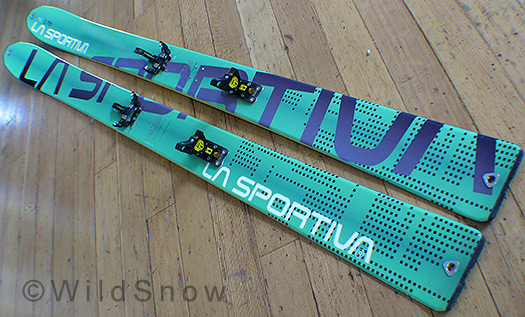
La Sportiva Hi5 backcountry skis, good weight performance ratio.
Joe: “The ‘Gators,’ as I like to call them due to their unique green diamond shaped tips, were an awesome definition of what it means to be an all encompassing deep-snow backcountry ski. I’ve skied them over the past two winters and still am not disappointed. In a package that includes precut Pomoca skins, easy attachment points forward and rearward, extreme lightweight, high levels of durability make for a very well rounded soft-snow ski. They are predictably surfy and playful on several occasions on the down with plenty of rocker abound. The sidecut offering in the 177 and their longer 185 did the work when asked to lay down some GS turns. Hi5 has a true featherweight feel on the uphills leaving me grinning ear to ear on multiple touring lap sessions. (Although the uphill feel could have been further aided due to our setup being pre-supplied with La Sportiva’s proprietary race binding). I would be happy to see this ski under my feet whenever the snow covers the toes of my boots, or higher.
We reviewed the Sportiva Hi5 some time ago. They’re a big, rockeristic surfy ski yielding an excellent weight/performance ratio. Though Lou found them to sometimes be a bit floppy when in variable conditions, he still says they’re a go-to. One of our top recommends for human powered powder skiing.
La Sportiva skis on sale here.
Trab Volare Trab skis on sale here.
Length tested: 171 cm, Sidecut: 129/99/116, Radius: 24.2m, Weight per ski: 52.1 oz, 1478 g
Soft snow: ****.
Hard snow: ***..
Weight/Performance: *****
It is genetically impossible for Trab to make a bad ski. Average, perhaps; groaner, never. What’s cool about Volare is it gives you that wider waisted plank without the rocker nearly everyone else includes. Why is that cool? Mainly, we like to downsize our ski length for true mountaineering. Downsizing rockered skis is difficult. Go too short and it feels like you’re on snowlerblades. Thus, we opted for a 171 in our test Volares. Previous review that includes back story on name.
Lou: “I’ll admit I did notice these skis were a bit more demanding than the longer, rockered rides I’ve also been on this winter. I skied the Volare about 30 days including many turns in variable Euro snow conditions, so my take is extensive. They’ve got good hardpack grip, engaging the turn in a more traditional way than a rockered ski, but still, they’re not a trenching tool. In soft snow I found them to be fun, bouncy and active — though the length I was on caused me to revert to tighter “euro style” turns. Yeah, I was in Europe when that happened so no one laughed. But my thighs got tired. Be it known that Bob Perlumutter tried to steal these from me, and they were my choice for Europe during two of my three trips over there this winter. Whatever details we get into below please keep those two factoids in mind.”
Bob Perlmutter: “I’ve now skied the Volare on corn as well as powder. Indeed it a very good all round ski. Reasonable weight for a plank in the 99-100 mm width which makes it very efficient on the uphill. Lively and responsive yet still damp and predictable on the downhill. Surprisingly stable for such a light ski. Also has a somewhat unique ability to maintain ski/snow contact or stay glued to the snow even with some good pop or energy coming out of the turn.”
“The Volare is a modern take on the traditional Euro AT ski. High tech materials, impeccable craftsmanship and a wide footprint without the rocker bell and whistle. The Volare reacts best to a more traditional narrower Euro stance and tighter Euro turns. It is responsive and energetic but each turns requires some patience as it likes some roundness to the turn radius. I also found that the preferred stance is right in the middle of the ski as too much tip pressure early in the turn causes the ski to overreact or overturn. Once I dialed in the sweet spot all was good. Despite the lack of rocker the Volare was right at home in the soft crud, tracking through cut-up powder with ease without any tip deflection.”
“All in all the Volare does everything well though not any one particular aspect famously. For some reason as I skied the Volare I kept having flashbacks to the late 70’s and 80’s with Degree 7 one-piece suits and pink head scarves as I danced down the mountain. Apparently Lou has some of the same visions, which probably has something to do with how long we’ve both been around.”
One more thing from the WildSnow editors: We should mention the proprietary skin attachment of the Volare. At the tip, the skin terminates in a tiny rod shaped deal, which you slide under the plastic ski tip protector. At the tail, a small cam-latch is inserted up through the Trab ski swallowtail, then snapped down. The attachment is good and solid, but for the life of us we couldn’t figure out how to easily strip skins with skis still on. Perhaps some of you have ideas on how to make the Volare skin attachment do your bidding? If so, please comment. At this point, we feel this system is overly complicated.
Volkl Nunataq Volkl Nunatag on sale here.
Length tested: 178 cm, Sidecut: 139/107/123, Radius: 27.4, Weight per ski: 63 oz, 1786 g
Soft snow: *****
Hard snow: ***..
Weight/Performance: *****
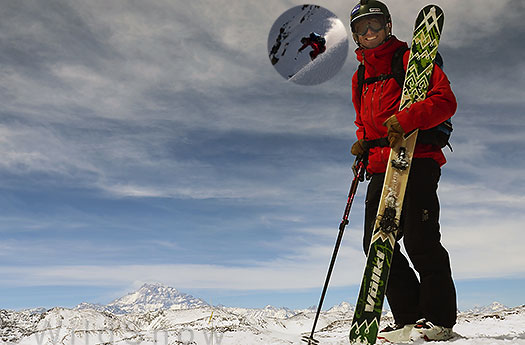
Anton Sponar riding Nonataq in Chile last summer.
Ooh la la, we like these. Width, rocker, lightweight. One of the best human-powered soft snow machines we tested. Not too shabby on the hardpack either. Downside is with full rocker (all the way from boot position, to front and rear) you need to ski these long. That means extra weight and awkwardness on the backpack or in exiguous situations. Our complete review gives total beta, in brief:
Volkl appears to have kept their ear very close to the snowpack and simply built what most freeride backcountry skiers want. Start with a 107 waist, use a weight-optimized wood core, bring the rocker all the way to the boot area, don’t bother with a turned up tail, have good skiers test them before going to market. If you like wider planks for backcountry skiing, keep this guy at the top of your short list. Only downside is you will notice the width and total rocker when you’re on piste, but you’ll survive till you get to the powder, crude, mank, trapcrust, chowder, butter, corn and slop these skis eat like a bear dining on your cooler contents.
Note that proprietary skins can be purchased for the Nunataq. These use the ski tip hole for attachment, with a buckle hook over the tail. As with most of these arrangements we’re not impressed and would prefer something along the lines of what Dynafit does with their skin attachment system. On the other hand, if you want to shop and go, the Volkl skins function. Advantage of skin systems such as that of Nunataq is given proper adjustment and a skin notch in the tail (which Nunataq does not have), they stay on when other types of skin systems get shaky (e.g., systems such as Dynafit can do funny things when you ski downhill with skins on, due to the skin shifting backwards, and without tail notch the tail fix can easily be knocked off the ski to the side).
Overall, Nunataq is an awesome combo of width, rocker and design that should make just about anyone happy.
Voile Vector Shop for Voile skis here.
Length tested: 180 cm, Sidecut: 121/96/110, Radius: 23m, Weight per ski: 55.5 oz, 1570 g
Soft snow: ****.
Hard snow: ***..
Weight/Performance: *****
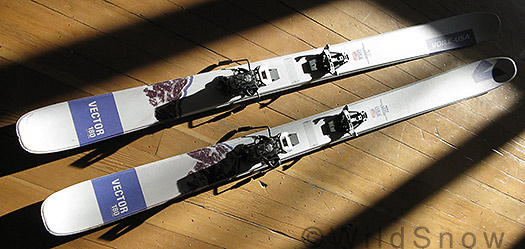
Modern geometry in a midfat.
It is no wonder that Voile sold out their whole stock of skis this year. When you offer something with the price/weight/performance ratio of the Vector (street price can be around $400), you deserve to sell through your planks like a funnel cake vendor handing out calories at a rodeo. Vectors have that perfect width for ski mountaineering. Wide, but not too fatty (unlike some of the cake consumers I saw at the last aggie event we attended). Requisite rocker along with average and adequate edge hold complete the recipe.
According to our reviewer, Anton Sponar, on a new route on Capitol Peak, Colorado: “I dropped in. Needless to say I was a bit nervous skiing steep firm snow above a 300 foot cliff. The Vectors made things much easier however. They felt solid. Once I had time to think (e.g., when I got to the bottom of the extremely long and scary rappel that completed our route), I was sold. The Vectors had done it all, and made it all fun.” More here.
Anton mentions in his review that he experienced one of the drawbacks of a rockered ski with a somewhat turned up tail, that being the feeling you lack enough tail for support when you throw your balance back from center. Some of you may be familiar with that feeling — or you might like having enough tail rise to throw moderate tricks now and then. In either case, be advised. Overall, another highly recommended ski in the quiver — and another that could be a quiver of one if so desired.
As far as shopping goes, these skis are hard to find. Look for them here.
***********************************
Well, that’s it for this year’s Ultimate Quiver. Doing the project this season was a bit of a challenge due to the lack of Colorado snow, but between our various testers we rode the planks enough for a good take. As was our goal, we gave each ski what we feel is a much more extensive vetting than is normal for ski “reviews.” We’ll probably do a similar project next year, only with fewer skis and an earlier publication date (assuming we have a normal winter). Please remember that this is a “quiver,” and thus only skis we’d select if we could keep a preferred selection in our get-ready room at WildSnow HQ.
Yes, other good skis exist. Some may be your favorites and you don’t see them here. Oh the pain, oh the angst! If so, our comments section below is available for your evangelical pleasure. And speaking of comments, feel free to ask us questions about the different skis, and discuss.
Our main testers: Lou you know who, Lisa WildSnow Girl, Joe the WildSnow Production Assistant, Anton the Aspen ski instructor and owner of Ski Arpa in Chile, Louie WildSnow progeny, and Bob Perlmutter manager and guide for Aspen Mountain Powder Tours (by way of qualifications Bob has more than 4,000 ski days under his feet, with around 1,500 of those being powder days, including the two powder days he had as a kid when skiing in Michigan. If it wasn’t for his pink head scarf and double pole plants, we’d hand the quiver to him and just walk away, but one has to be discerning when it comes to ski testers… Also thanks for the feedback from other folks, too numerous to mention.
On high hazard days, we tested skis on mountains managed by Aspen Snowmass Ski Company. Thanks to them for comp tickets.
While most of the WildSnow backcountry skiing blog posts are best attributed to a single author, some work well as done by the group.

